- ホーム
- > 洋書
- > 英文書
- > Business / Economics
Full Description
This addition to the ISOR series introduces complementarity models in a straightforward and approachable manner and uses them to carry out an in-depth analysis of energy markets, including formulation issues and solution techniques.







